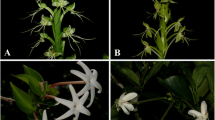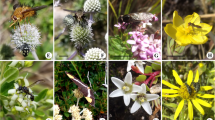Abstract
The immobility of plants and the need for third-party vectors to enact pollen transfer render pollination an inherently spatial process. Little is known about the spatial scales over which pollen transfer and plant reproductive success are dependent on mate availability in natural plant populations. Dioecious plants provide useful study systems for examining the dependence of reproductive success on spatial patterns of mate availability because potential pollen donors and recipients are unambiguous. We examined the spatial dynamics of pollination in the dioecious shrub Shepherdia canadensis (L.) Nutt. (Elaeagnaceae) at a range of spatial scales in Ivvavik National Park, Canada. On average, males occurred at higher frequencies than females across ten study sites with at least 60 S. canadensis plants per site. Although we detected substantial variation in sex ratios across sites, there was no association between sex ratio and fruit set. Instead, patterns of fruit set were significantly correlated with male density within sites, over distances of 4–6 m. The density of females and males was spatially cross correlated. Therefore, density effects appear to be driven by pollinator responses to the overall density of shrubs. A pollinator exclusion experiment indicated that syrphid flies (Family: Syrphidae) were the most important pollinators in these populations. This study demonstrates that female reproductive success in S. canadensis is limited by plant density over small spatial scales, corresponding with the short foraging distances characteristic of its fly pollinators.




Similar content being viewed by others
References
Ahee JE, Van Drunen WE, Dorken ME (2015) Analysis of pollination neighbourhood size using spatial analysis of pollen and seed production in broadleaf cattail (Typha latifolia). Botany 93:91–100
Álvarez-Cansino L, Zunzunegui M, Barradas MCD, Esquivias MP (2010) Gender-specific costs of reproduction on vegetative growth and physiological performance in the dioecious shrub Corema album. Ann Bot 106:989–998
Barrett SCH, Hough J (2013) Sexual dimorphism in flowering plants. J Exp Bot 64:67–82
Barrett SCH, Thomson JD (1982) Spatial pattern, floral sex ratios, and fecundity in dioecious Aralia nudicaulis (Araliaceae). Can J Bot 60:1662–1670
Barrett SCH, Yakimowski SB, Field DL, Pickup M (2010) Ecological genetics of sex ratios in plant populations. Philos T R Soc B 365:2549–2557
Bates D, Maechler M, Bolker BM, Walker S (2014) lme4: Package ‘lme4’ http://CRAN.R-project.org/package=lme4
Beattie AJ (1971) A technique for the study of insect-borne pollen. Pan-Pacific Entomol 47:82
Borkent CJ, Harder LD (2007) Flies (Diptera) as pollinators of two dioecious plants: behaviour and implications for plant mating. Can Entomol 139:235–246
Burkle LA, Alarcón R (2011) The future of plant-pollinator diversity: understanding interaction networks across time, space, and global change. Am J Bot 98:528–538
Charnov EL (1979) Simultaneous hermaphroditism and sexual selection. PNAS 76:2480–2484
Charnov EL (1986) Size advantage may not always favor sex change. J Theor Biol 119:283–285
Crawley MJ (2007) The R book. Wiley, Chichester
Dawson TE, Bliss LC (1989) Patterns of water use and the tissue water relations in the dioecious shrub, Salix arctica: the physiological basis for habitat partitioning between the sexes. Oecologia 79:332–343
de Jong TJ, van der Meijden E (2004) Sex ratio of some long-lived dioecious plants in a sand dune area. Plant Biol 6:616–620
de Jong TJ, Batenburg JC, Klinkhamer PGL (2005) Distance-dependent pollen limitation of seed set in some insect-pollinated dioecious plants. Acta Oecol 28:331–335
Elberling H, Olesen JM (1999) The structure of a high latitude plant-flower visitor system: the dominance of flies. Ecography 22:314–323
Fromhage L, Kokko H (2010) Spatial seed and pollen games: dispersal, sex allocation, and the evolution of dioecy. J Evol Biol 23:1947–1956
García MB, Antor RJ, Espadaler X (1995) Ant pollination of the palaeoendemic dioecious Borderea pyrenaica (Dioscoreaceae). Plant Syst Evol 198:17–27
Garibaldi LA et al (2013) Wild pollinators enhance fruit set of crops regardless of honey bee abundance. Science 339:1608–1611
Gómez JM, Abdelaziz M, Lorite J, Jesús Muñoz-Pajares A, Perfectti F (2010) Changes in pollinator fauna cause spatial variation in pollen limitation. J Ecol 98:1243–1252
Hamilton WD (1967) Extraordinary sex ratios. Science 156:477–488
Hesse E, Pannell JR (2011) Density-dependent pollen limitation and reproductive assurance in a wind-pollinated herb with contrasting sexual systems. J Ecol 99:1531–1539
Hickman JC (1974) Pollination by ants: a low-energy system. Science 184:1290–1292
House SM (1992) Population density and fruit set in three dioecious tree species in Australian tropical rain forest. J Ecol 80:57–69
Hull DA, Beattie AJ (1988) Adverse effects on pollen exposed to Atta texana and other North American ants: implications for ant pollination. Oecologia 75:153–155
Karst AL, Antos JA, Allen GA (2008) Sex ratio, flowering and fruit set in dioecious Rubus chamaemorus (Rosaceae) in Labrador. Can J Bot 86:204–212
Kearns CA, Inouye DW (1993) Techniques for pollination biologists. University Press of Colorado, Niwot
Kearns CA, Inouye DW, Waser NW (1998) Endangered mutualisms: the conservation of plant-pollinator interactions. Annu Rev Ecol Syst 29:83–112
Kevan PG, Baker HG (1983) Insects as flower visitors and pollinators. Annu Rev Entomol 18:407–453
Klein AM et al (2007) Importance of pollinators in changing landscapes for world crops. Proc R Soc B 274:303–313
Kunin WE (1993) Sex and the single mustard: population density and pollinator behavior effects on seed-set. Ecology 74:2145–2160
Lewis GM (1990) Sex ratios, sexual dimorphism and site dynamics in the dioecious shrub Shepherdia canadensis (L.) Nutt. Dissertation, University of Calgary
Lin S-Y (2014) Spatial dynamics of pollination in dioecious Shepherdia canadensis in Yukon. Thesis. Trent University
Makino TT, Ohashi K, Sakai S (2007) How do floral display size and the density of surrounding flowers influence the likelihood of bumble bee revisitation to a plant? Funct Ecol 21:87–95
Nock CA, Caspersen JP, Thomas SC (2008) Large ontogenetic declines in intra-crown leaf area index in two temperate deciduous tree species. Ecology 89:744–753
Obeso JR (2002) The costs of reproduction in plants. New Phytol 155:321–348
Öster M, Eriksson O (2007) Sex ratio mediated pollen limitation in the dioecious herb Antennaria dioica. Ecoscience 14:387–398
Pinheiro J, Bates D, DebRoy S, Sarkar D, R Core Team (2012) nlme: linear and nonlinear mixed effects models. R package verion 3. pp. 1–109
Rudgers JA, Gardener MC (2004) Extrafloral nectar as a resource mediating multispecies interactions. Ecology 85:1495–1502
Scoggan HJ (1979) The flora of Canada, vol 4. National Museum of Natural Sciences, Publications in Botany, Ottawa
Skaug H, Fournier D, Bolker B, Magnusson A, Nielsen A (2014). Generalized Linear Mixed Models using AD Model Builder. R package version 0.8.0
Smouse PE, Dyer RJ, Westfall RD, Sork VL (2001) Two-generation analysis of pollen flow across a landscape. Male gamete heterogeneity among females. I. Evolution 55:260–271
Sokal RR, Rohlf FJ (1995) Biometry, 3rd edn. WH Freeman and Company, New York
Sork VL et al (2002) Pollen movement in declining populations of California Valley oak, Quercus lobata: where have all the fathers gone? Mol Ecol 11:1657–1668
Stehlik I, Friedman J, Barrett SCH (2008) Environmental influence on primary sex ratio in a dioecious plant. Proc Natl Acad Sci 105:10847–10852
Stephenson SN (1986) A comparison of life history characteristics of selected dioecious plants in Michigan. Mich Acade 18:159–174
Van Drunen WE, Dorken ME (2012) Trade-offs between clonal and sexual reproduction in Sagittaria latifolia (Alismataceae) scale up to affect the fitness of entire clones. New Phytol 196:606–616
Westerbergh A, Saura A (1994) Gene flow and pollinator behaviour in Silene dioica populations. Oikos 71:215–224
Acknowledgments
We thank Kayla Arey, Eva Esmann Behrensfor, Blythe Browne, Rebecca Conlan, David Elwood, Tyee Fellows, Jay Frandsen, Judy Frandsen, Bronwen Hennigar, Ariana Hauck, Rebecca Kaufman, Melissa Lennie, Pinette Robinson, and George Zorn for their assistance in the field. We are particularly grateful to Linh Nguyen and Parks Canada staff in the Western Arctic Field Unit for their support and care in Ivvavik National Park and to Bill Crins of the Ontario Ministry of Natural Resources and Forestry for his assistance with pollinator identification. Joanna Freeland and an anonymous reviewer provided helpful comments on previous versions of the manuscript. Funding was provided by the National Science and Engineering Research Council through the Canadian Pollination Initiative (CANPOLIN) to EN and MED, Northern Scientific Training Program (NSTP) grants to SYL, Parks Canada, Wildlife Management Advisory Council (North Slope), and Trent University.
Author information
Authors and Affiliations
Corresponding author
Additional information
Communicated by Satoki Sakai.
Electronic supplementary material
Below is the link to the electronic supplementary material.
Rights and permissions
About this article
Cite this article
Lin, SY., Nol, E. & Dorken, M.E. Spatial dynamics of pollination in dioecious Shepherdia canadensis (Elaeagnaceae). Plant Ecol 216, 1213–1223 (2015). https://doi.org/10.1007/s11258-015-0502-8
Received:
Accepted:
Published:
Issue Date:
DOI: https://doi.org/10.1007/s11258-015-0502-8




